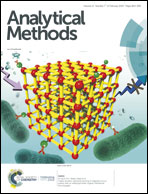Papain-stabilized silver nanoclusters: dual emission and ratiometric fluorescent sensing of ferrous ions†
Abstract
Herein, a dual emissive fluorescent probe based on papain-stabilized Ag nanoclusters was developed. The as-prepared papain–Ag NCs showed a ratiometric fluorescent response to Fe2+, while other cations and anions had no effects on the fluorescence of the papain–Ag NCs. The emissions at 454 nm and 647 nm both decreased and the ratio of the fluorescence intensity at the two wavelengths (F454/F647) had a good linear relationship with the concentration of Fe2+. This probe could be used for detecting Fe2+ in the range from 1.5 to 120.0 μmol L−1 with a detection limit of 500 nmol L−1, which was comparable to or better than those of some other fluorescence approaches for Fe2+ sensing. The responding mechanism was attributed to the chelation of glycine (Gly) residue in the papain ligand with Fe2+, which led to the fluorescence quenching of the papain ligand at 454 nm due to the static quenching effect and reduced the charge transfer from the papain ligand to Ag NCs resulting in the fluorescence quenching of Ag NCs at 647 nm. Moreover, the papain–Ag NC probe was extended to the detection of Fe2+ in a real sample of ferrous lactate oral solution with satisfactory results compared with the standard 1,10-phenanthroline method.



 Please wait while we load your content...
Please wait while we load your content...